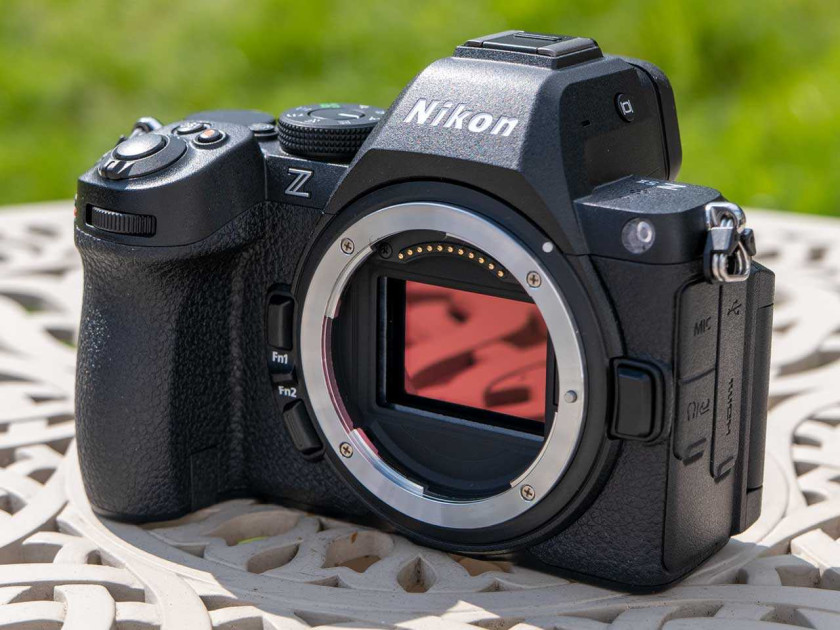
Check out our latest products

Introduction
The Nikon Z5 II is an entry-level 35mm full-frame mirrorless camera that offers 4K/60p video, up to 30fps burst shooting, and IBIS.
This is the long-awaited replacement for 2020’s Z5 model. It sits below the better-specced and higher-priced Z6 III model in the Nikon Z-series range.
Other key features of the Z5 II include a 24.5 megapixel BSI CMOS sensor, ISO range of 100-64000 , 273-point Hybrid AF system with AI-driven subject detection, 3690k-dot electronic viewfinder, vari-angle touchscreen LCD, weatherproof magnesium alloy body, dual UHS-II SD card slots, and built-in Wi-Fi and Bluetooth.
The Nikon Z5 II is available now in black only, priced at £1599 body only, £1859 for the 24-50mm kit, £2129 for the 24-70mm f/4 kit and £2299 for the 24-200mm kit. It is made in Thailand.
Read on for our in-depth Nikon Z5 II review, complete with full-size sample photos and videos for you to download and evaluate.
Ease of Use
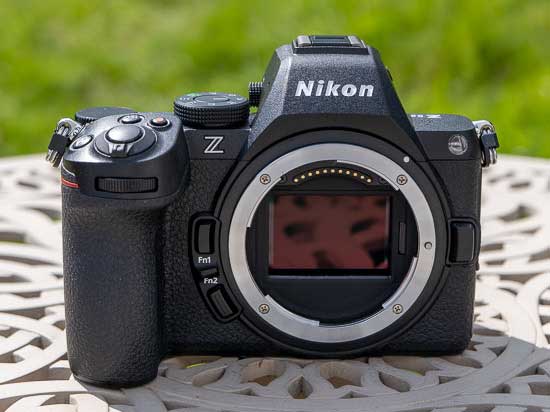 |
As the model name suggests, this unit sits below the existing ‘6’ and ‘7’ semi pro models in its maker’s line up, the premise here being that this is a more accessible entry point into the ‘Z’ series for those who don’t want the steep learning curve they may perceive the higher priced alternatives present.
That said, while comparable with other mirrorless camera options out there, the £2129 being asked for the camera and 24-70mm f/4 lens bundle we were sent by Nikon isn’t cheap for a ‘beginner’ or smartphone upgrader by any means.
Nikon has used pretty much the same body design for the Z5 II as the original Z5, which doesn’t come as a great surprise in a mature market where upgrades are less frequent and more incremental.
Measuring 134 x 100.5 x 72 mm (5.3 × 4 × 2.9 in.) and weighing 700 g (1 lb. 8.7 oz.) with battery and memory card, fitted, it is a few mm larger and 325g heavier than its predecessor, mainly to accommodate the chunkier hand grip, which we think is definitely worth the trade off for the slightly better handling that it offers.
Otherwise you’d be hard-pressed to to tell the two cameras apart side-by-side, with the external control layouts being pretty muchidentical – it’s inside the camera where the majority of the improvements have been made.
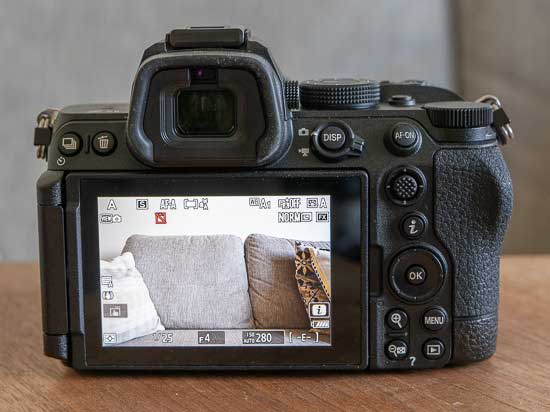 |
Burst shooting rates and buffer capacities have been greatly improved in this new Z5 II model compared to the five-year-old original.
While the Z5 can only shoot at a rather pedestrian 4.5fps, the Z5 II cranks things up to a whole other level, offering 30fps burst shooting for JPEG and 14fps/11fps for RAW.
In addition, the Z5 II also boasts Pre-Release Capture mode, a great feature that makes it easier to capture the decisive moment even when shooting at 30fps.
When activated, the camera can buffer images up to 1 second before you fully depress the shutter button. Burst shooting then starts when the shutter is half-pressed and the buffer will retain up to 1 seconds worth of frames after fully pressing the shutter.
There is one important caveat when using this mode, which applies to all the Nikon camera that offer it to date. Pre-Release Capture is only available when shooting JPEGs, not RAW files, whereas som,e rival cameras support both JPEG and RAW formats for its equivalent feature.
 |
Backing up the improved burst shooting and making the Z5 II much better suited to wildlife and sports photography is the revamped auto-focus system which is very similar to the one found on the flagship Z8/Z9 models.
The 273-point phase-detection AF system is claimed to be 68% faster than the Z5. When paired with an F1.2 lens, the Z5 II boasts AF sensitivity that means it can auto-focus down to an incredible -10EV, even when not using the special Starlight AF shooting mode.
3D Tracking AF is inherited from the company’s DSLR cameras helps the Z6 III to track fast-moving subjects, with the camera using a single AF point to track whatever’s underneath it while you half-press the shutter button.
The new Z5 II offers the same 9 AI-driven subject-detection modes as the more premium Z9, Z8 and Z7 III models, including a dedicated bird mode, while the new Intelligent AF-A mode for beginners means there’s no need to change focus modes yourself.
Another useful improvemenet is the small subject detect mode which uses only 3% of the frame, useful if you don’t have a long enough lens for birds.
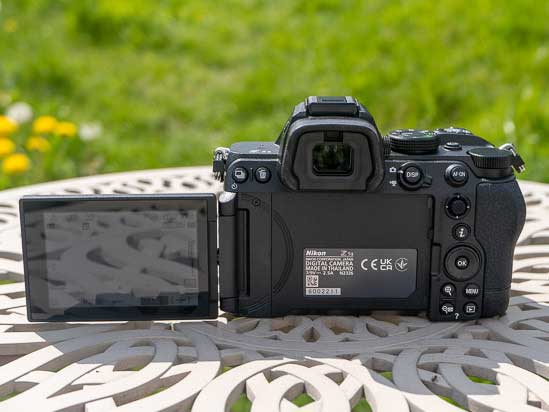 |
In terms of AF performance, the Z5 II represents a big improvement when compared with the Z5, getting it right a lot more frequently than that camera did and making it much easier to recommend for anybody that shoots a lot of moving subjects, such as wildlife or sport.
The in-body image stabilization system has been significantly improved with the Z5 II offering 7.5 stops in the centre and 6 stops at the edges of the frame of 5-axis image stabilisation built into the camera’s body, up from 5 stops on the Z6 II, plus there’s electronic-VR for video recording. The optional Focus Point VR feature stabilises the area around the active focus point when shooting stills.
The Z5II’s video capabilities have also gained a significant upgrade in the four years since the release of the Mark I version.
Both the Z5 II and Z5 offer 4K UHD video recording, but the Z5 has a number of serious limitations which makes the newer Z5 II a much better choice for more serious videographers.
The Z5 II’s video quality tops out at 4K 60/50p cropped to the 1.5x DX format, whereas the original Z5 doesn’t offer that recording mode at all.
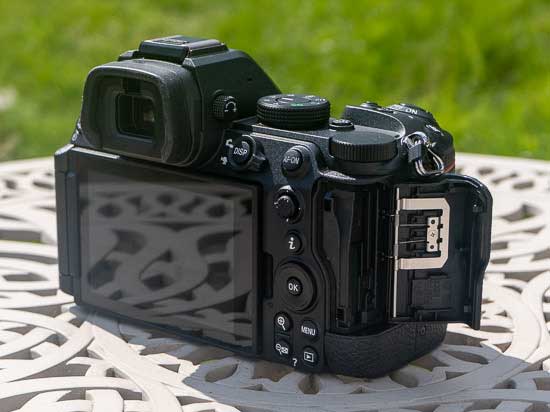 |
Instead the Nikon Z5 applies a massive 1.7x crop to its best 4K/30p video, whereas the Z5 II captures oversampled 6K footage and therefore produces more detailed results with no crop at all.
The aggressive crop on the Z5 also means that you’ll need to use wider-angle focal lengths to achieve the same field of view as the Z5 II, and faster lenses to achieve the same depth of field, something that will prove particularly problematic for avid vloggers who will be forced to position the camera further away than at arms length.
Thankfully in 1080p / Full HD mode both cameras shoot with no crop at all, but again the Z5 II has the edge thanks to its 120fps super-slow-mo mode, with the Z5 topping out at 60fps.
Finally, the Z5 II additionally offers N-Raw internal recording to UHS-II SD card, 10-bit N-Log recording for advanced profiling during post-production plus HLG and SDR modes, RED Luts, improved electronic VR, the Product Review mode from the Z50 II, 2x High-Res zoom with any lens, even a prime, in 1080p quality, a video self-timer and USB streaming.
Surprisingly recording times are slightly longer on the original Z5 – up to 120 minutes versus 85 minutes on the newer version.
 |
The Z5 offers a native ISO range of 100-51200 while the Z5 II runs from 100-64000.
Crucially, though, the Z5 II can be pushed two stops further to ISO 204800, whereas the Z5 can only be expanded to ISO (102400). Both can drop down to ISO 50 if required.
The Z5 II also has a slight edge on the video side by providing an ISO range of 100–51200 versus the Z5’s 100–25600.
Both models offer a fastest shutter speed of 1/8,000sec for both stills and video.
Outwardly the new Z5 II looks and feels very similar to its predecessor, but there are a few subtle differences of note.
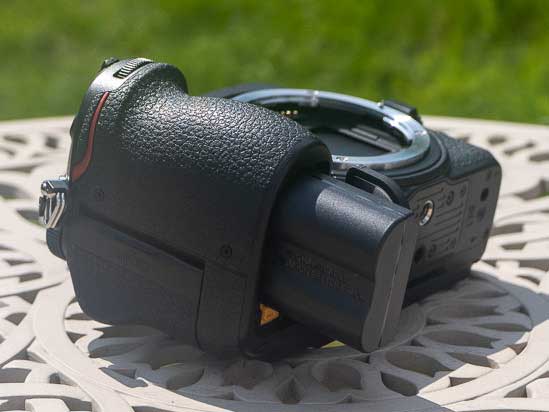 |
The newer model offers improved Z6 III levels of weather-proofing. It also has a deeper handgrip than the Z5 and features the same button layout as the new generation of Z8/Z9 cameras.
The Z5 II has the same dedicated Picture Control button from the Z50 II model which provides quick access to the 31 different Picture Controls. On the Z5 you had to dive into the menu system to select one of the 28 different modes.
You can also download recipes from Nikon Cloud onto the Z5 II and even create your own recipes in NX Studio.
The Z5 and Z5 II share a very similar 0.5-inch, 3.69 million-dot OLED electronic viewfinder, which offers 100% horizontal and vertical coverage, 0.8x magnification and 21mm eyepoint).
Looking through the viewfinder of both cameras is not quite identical, however, as the Z5 II has a 3,000 nit viewfinder (on par with the Z8/Z9) whereas the Z5’s screen has a brightness of 1000 cd/m².
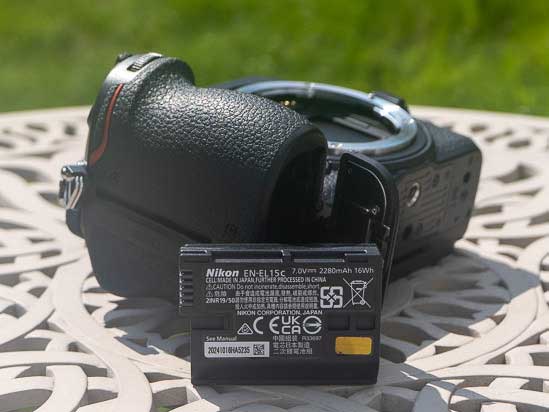 |
The Z5 has a 3.2-inch, 1.04-million dot resolution touchscreen LCD on the rear that can be tilted to 45 degrees,
The Z5 II’s 3.2 inch screen offers higher 2.1-million dot resolution and now has a vari-angle design that’s much better suited to both video and stills.
The Z5II has two memory card slots, utilising dual UHS-II SD slots housed in a dedicated compartment on the side of the body.
Both the Z5 amd Z5II models use the same EN-EL 15C battery, which allows the camera to be powered by USB whilst you’re using it, especially handy for timelapse photography or video and for travel photography when carrying a powerful powerbank.
On the Z5 it provides a CIPA-approved lifespan of 390 stills or 115 mins of video when using the EVF, or 470 stills or 120 mins of video when using the LCD screen, compared to 330 shots or 85 mins of video on the Z5 II when using the EVF and 380 shots when using the LCD screen.
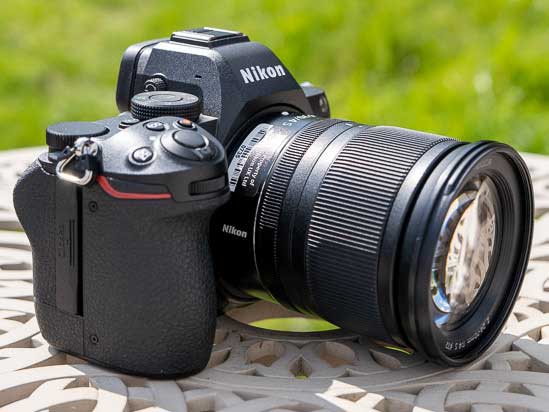 |
With lens mount front and centre on this model, the faceplate is a relatively minimalist affair, with a lens release button on one side of the mount flanked on the other by two slightly smaller function buttons.
Of course we also get the familiar screw head sized porthole housing a self time/AF assist lamp top right of the lens mount, and a deep, sculpted handgrip over on the left.
This has the familiar edge of a ridged control wheel poking out near the top where it falls under the forefinger, though we more often found ourselves using the more prominent ‘main’ command dial that is alternatively set into the top plate just above the thumb pad at the rear.
It just feels more natural to us to give this one a thumb spin, while your forefinger is free to hover over the shutter release button, and that button alone.
One thing this camera is missing however – though of course beginners won’t sweat over its omission – is a top plate LCD window. Perhaps this would have been something of a luxury, given that its maker was aiming for compactness here.
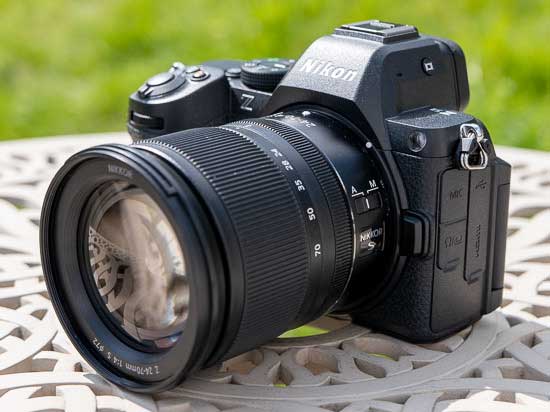 |
Top plate controls including the aforementioned main command dial and familiar shooting mode wheel – featuring the usual P,A,S,M and auto settings, plus three user-customisable ones – are reassuringly large and chunky, making for fluid, as opposed to fiddly, operation.
These have just the right amount of give and are not overly stiff, the user hearing an audible ‘click’ when a particular shooting mode is selected, or a reassuring series of clicks when the main command wheel is spun.
The top plate is also where you’ll find the Nikon Z5’s unobtrusive speaker, while stereo microphones sit either side of the familiar pentaprism shape, which houses the camera’s electronic viewfinder and built-in stereo microphones.
The degree of visibility you get from the 3690K-dot resolution EVF here is sufficiently impressive that we forgot we weren’t looking through an actually optical viewfinder. Said EVF also helpfully provides 100% frame coverage, so what you’re seeing is what you’re shooting.
Another thing that is missing here, however, that you wonder if Nikon could have included, is a pop-up flash – as it is, there’s a vacant hotshoe for attaching an accessory flashgun if and when required, though obviously this is at additional cost.
 |
Falling under the forefinger as it dances around the shutter release button meanwhile are an ergonomically arranged top plate trio of buttons – one for controlling exposure compensation (an incrementally broad +/- 5EV), another for accessing ISO settings in conjunction with a twirl of the command wheel as you hold this button down, plus a familiar record button for the commencing and canceling video capture
The back plate of the Nikon Z5 II meanwhile finds the camera at its busiest looking and possibly initially daunting, with a DSLR-like array of buttons arranged in a L-shape along the top, plus down the right hand side of the vari-angle LCD screen.
Top left where they conveniently fall under the thumb of the left hand, we get immediately recognizable buttons for drive mode selection (accessing single shot, burst shooting and standard self timer options) and file deletion, while, over at the other side of the viewfinder window, we find a display button encircled by a rocker switch for self explanatorily switching between stills and video capture.
To the right of these we get an AF-on button and a joystick with roughened surface so you literally get a ‘feel’ for its operation and directing of your AF point – activated via a press of the ‘OK’ button below – without having to take your eye away from the viewfinder.
Between the joystick and the OK button, set into a multi directional control pad, is an ‘i’ button, which by default provides a short cut to an on-screen toolbar of key shooting settings. Each setting has its own lozenge shaped virtual button, which are just of sufficient size to be able to nudge lightly with a thumb and avoid miss-selection. This also saves deep diving into the menu screens proper on most occasions.
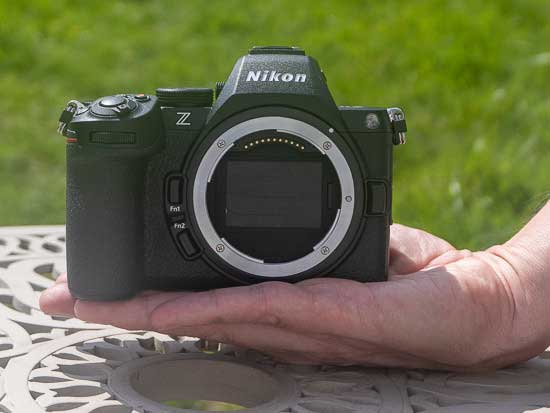 |
Beneath the multi directional control are a further quartet of buttons – being the self explanatory ‘menu’, a playback button, plus two magnifying glass illustrated enlarge and minimise buttons, which obviously come into their own when checking critical focus with the camera placed in playback mode.
With all the above seeming pretty straightforward and logical, the right hand flank of the camera – as viewed from the back – features the slide-and-open cover housing the dual memory card slots as discussed earlier, while the opposite flank features the camera’s connectivity options.
Here you get more than we might expect on a ‘beginner’ model, including the ability to plug in an external microphone and a pair of headphones for monitoring, while HDMI and USB ports are also provided, along with an accessory terminal option for plugging in a remote shutter release; so, these are commendably comprehensive options for a camera in this class (if not in this price bracket).
With Wi-Fi and Bluetooth on board as standard, the base of the Nikon Z5 features a screw thread for a tripod dead centre of its lens mount, while the base of the handgrip houses its rechargeable EN-EL15C lithium ion battery.
Image Quality
All of the sample images in this review were taken using the 24.5 megapixel Fine JPEG setting, which gives an average image size of around 10Mb.
Noise
The expanded ISO sensitivity can be set between ISO 50 and ISO 204800 in full-stop increments. Here are some 100% crops which show the noise levels for each ISO setting, with JPEG on the left and RAW on the right.
File Quality
The Nikon Z5 II has several different JPEG and RAW image quality settings available, with Fine* being the highest quality JPEG option. Here are some 100% crops which show the quality of the various options, with the file size shown in brackets.
Active D-lighting (ADL)
D-lighting is Nikon’s dynamic range optimisation tool that attempts to squeeze the full dynamic range of the sensor into JPEGs. Active D-lighting works “on the fly”, before the in-camera processing engine converts the raw image data into JPEGs. The available settings are Off, Low, Normal, High and Extra High, plus an Auto mode.
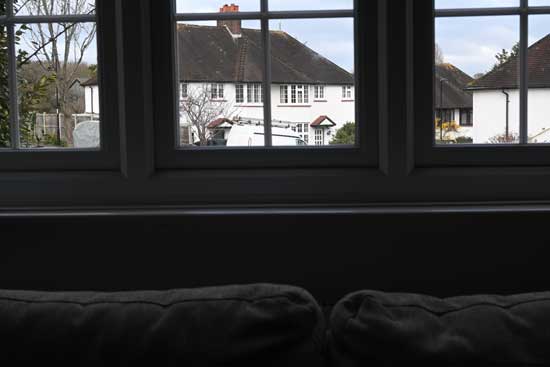 Off
Off
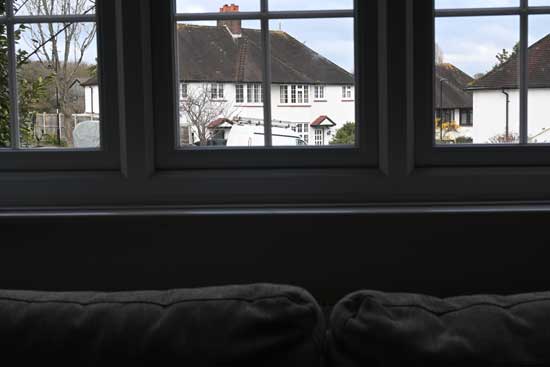 Low
Low
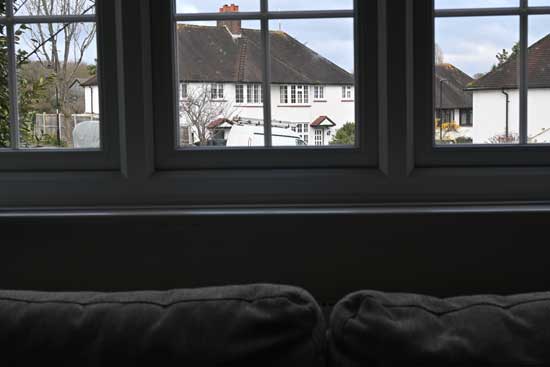 Normal
Normal
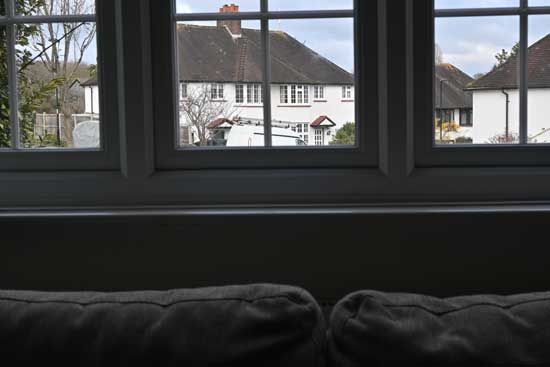 High
High
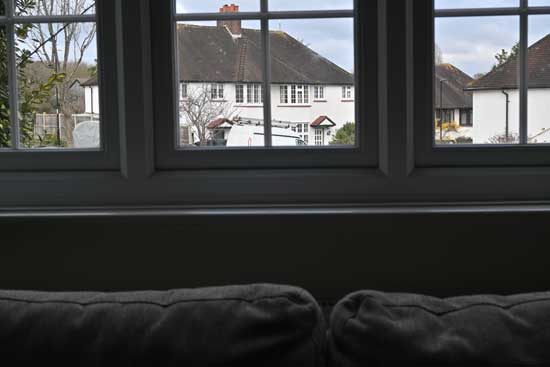 Extra High
Extra High
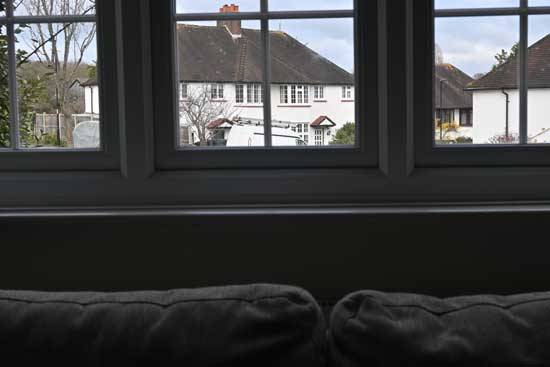 Auto
Auto
HDR
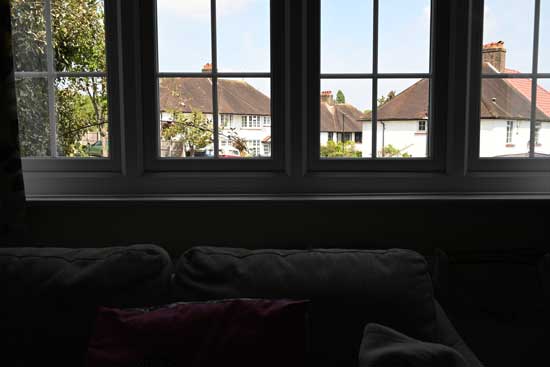 Off
Off
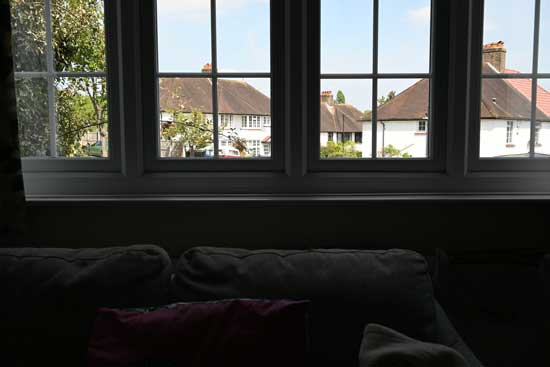 Low
Low
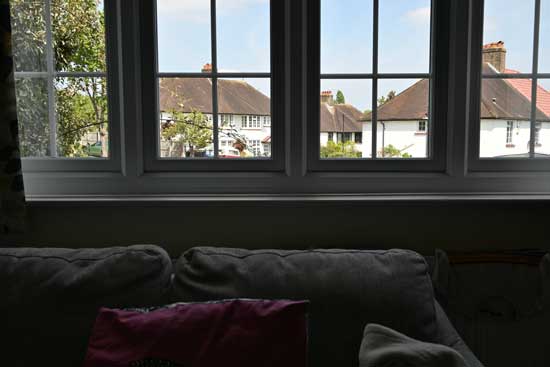 Normal
Normal
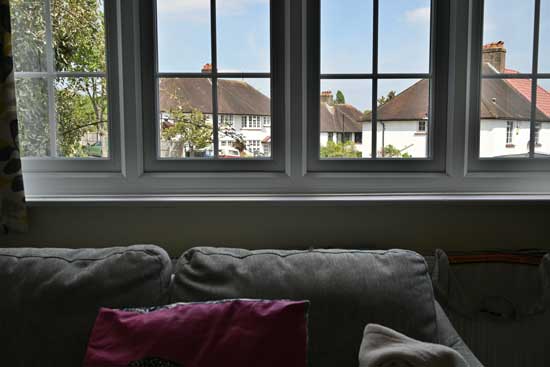 High
High
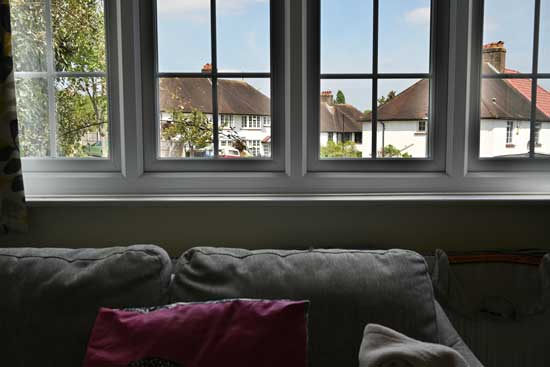 Extra High
Extra High
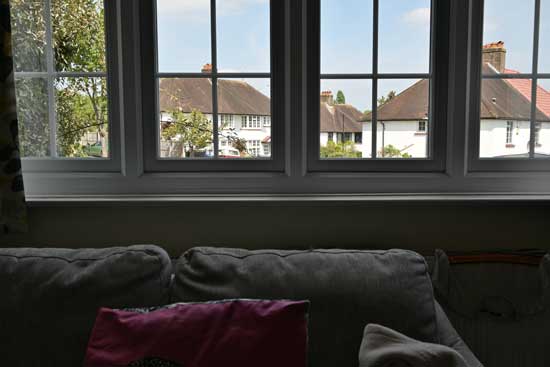 Auto
Auto
Multiple Exposure
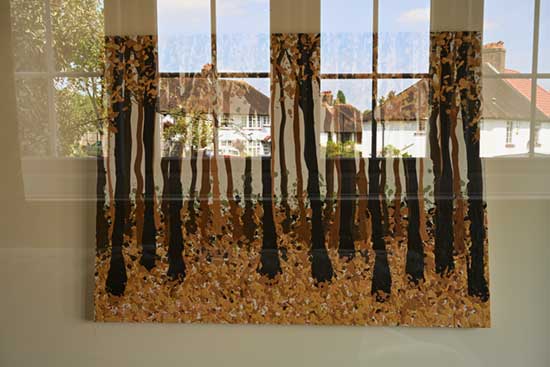
Picture Controls
Nikon’s Picture Controls are preset combinations of sharpening, contrast, brightness, saturation and hue. All 31 different Picture Controls can be tweaked to your liking, then saved and transferred to other cameras.
 Auto
Auto
 Standard
Standard
 Neutral
Neutral
 Vivid
Vivid
 Monochrome
Monochrome
 Flat Monochrome
Flat Monochrome
 Deep Tone Monochrome
Deep Tone Monochrome
 Portrait
Portrait
 Rich Tone Portrait
Rich Tone Portrait
 Landscape
Landscape
 Flat
Flat
Creative Picture Controls
 Dream
Dream
 Morning
Morning
 Pop
Pop
 Sunday
Sunday
 Somber
Somber
 Dramatic
Dramatic
 Silence
Silence
 Bleached
Bleached
 Melancholic
Melancholic
 Pure
Pure
 Denim
Denim
 Toy
Toy
 Sepia
Sepia
 Blue
Blue
 Red
Red
 Pink
Pink
 Charcoal
Charcoal
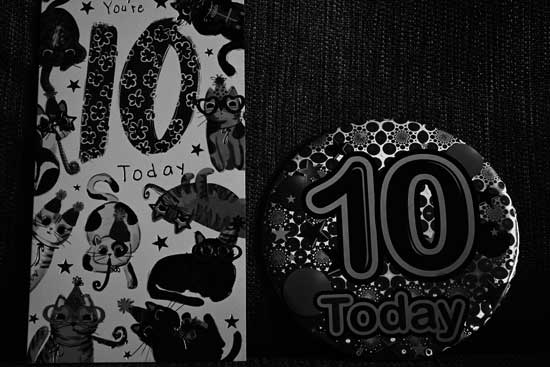 Graphite
Graphite
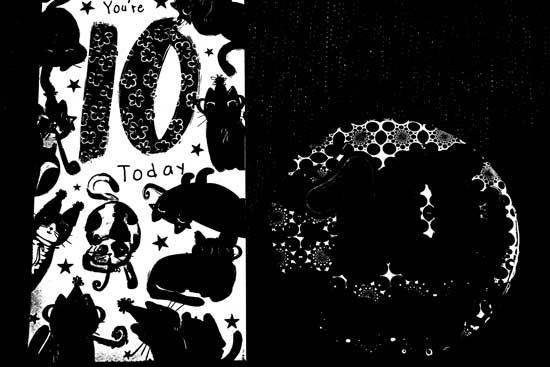 Binary
Binary
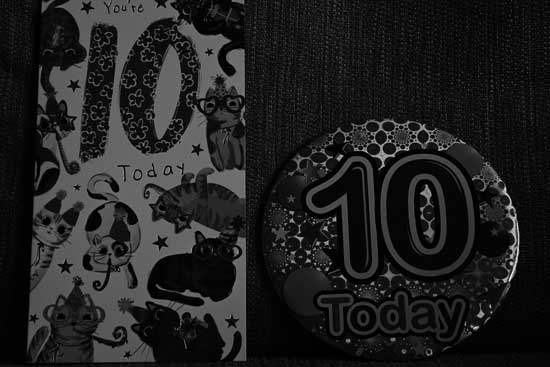 Carbon
Carbon
Sample Images
This is a selection of sample images from the Nikon Z5 II camera, which were all taken using the 24.5 megapixel Fine JPEG setting. The thumbnails below link to the full-sized versions, which have not been altered in any way.
Sample RAW Images
The Nikon Z5 II enables users to capture RAW and JPEG format files. We’ve provided some Nikon RAW (NEF) samples for you to download (thumbnail images shown below are not 100% representative).
Sample Movies & Video
As of February 2025, we are no longer providing full size sample images or videos for download.
Please contact us if you have any feedback on our new policy.
Product Images


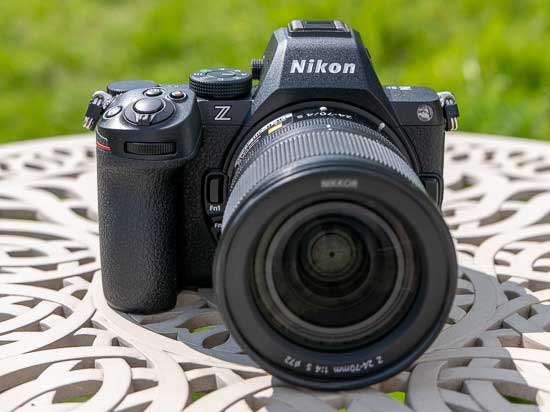
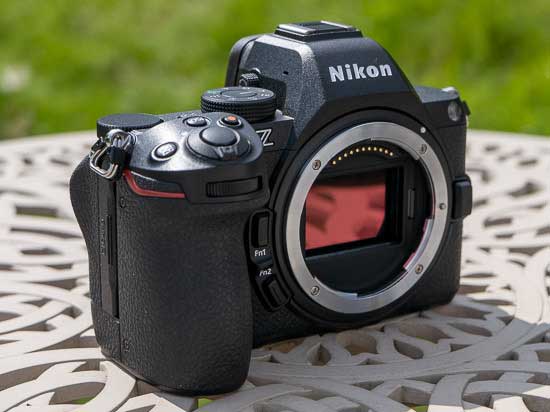

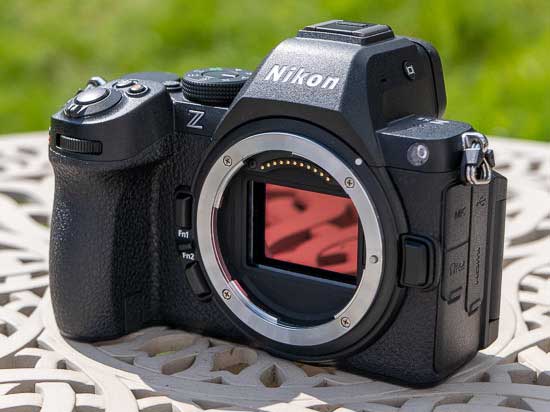



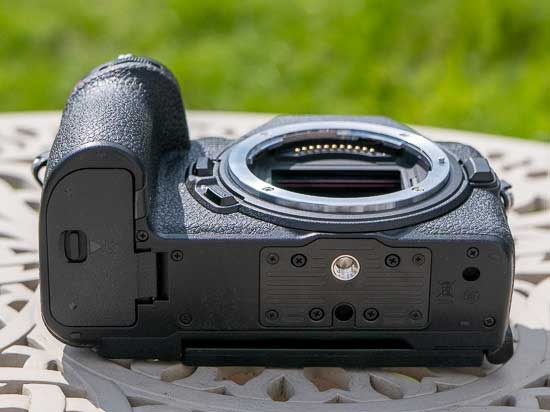
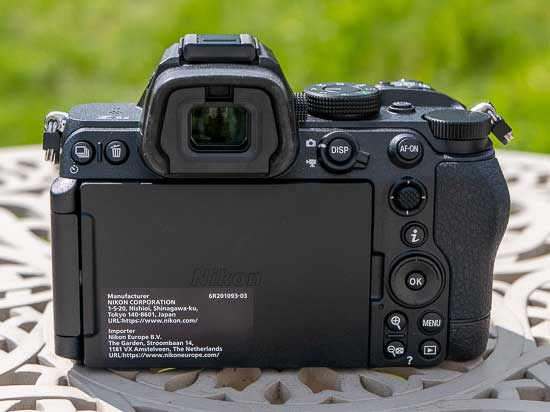
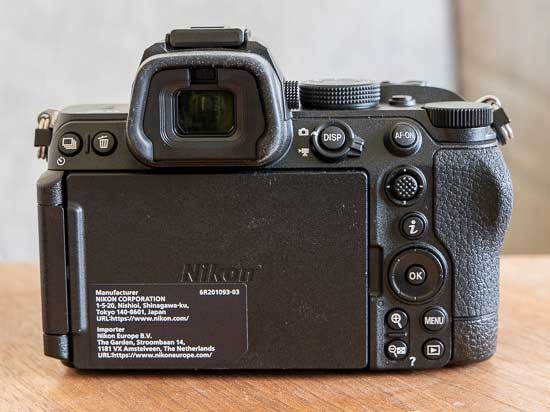
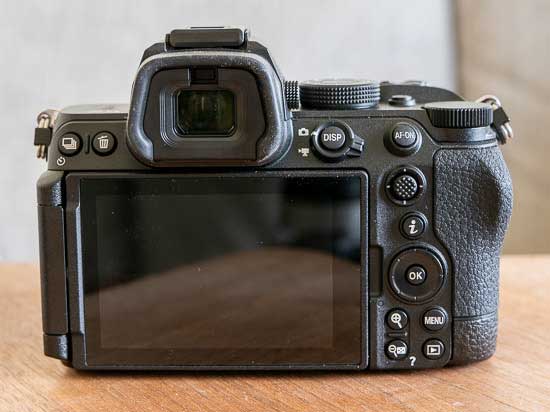

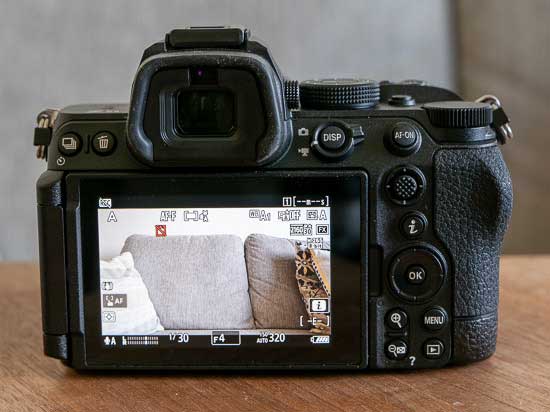
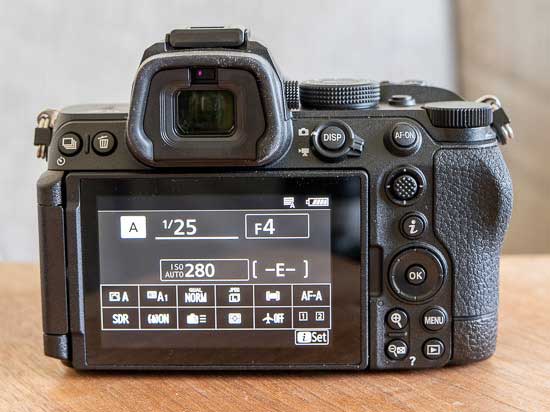
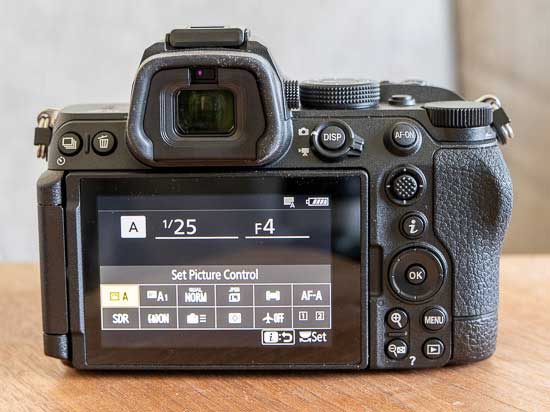
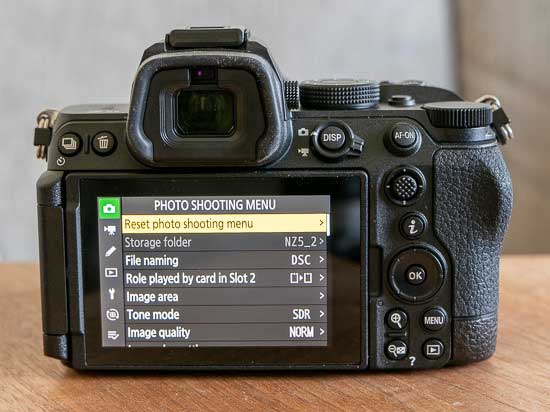
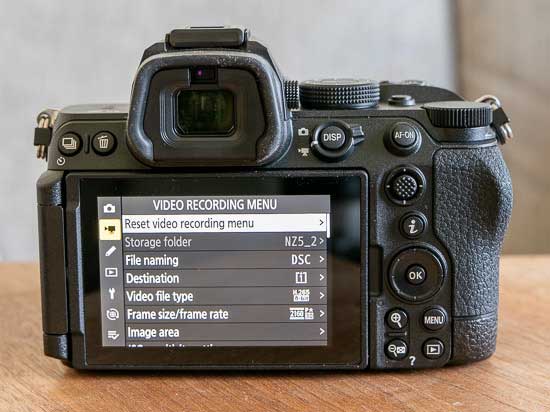


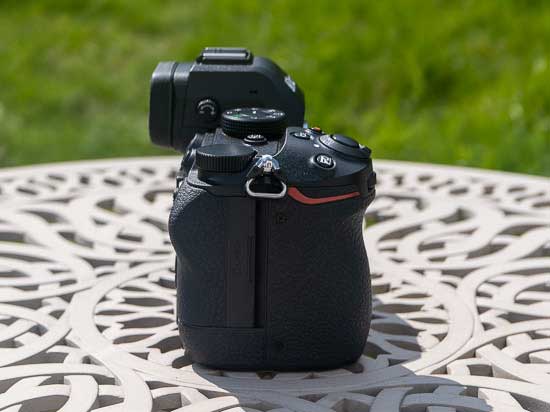

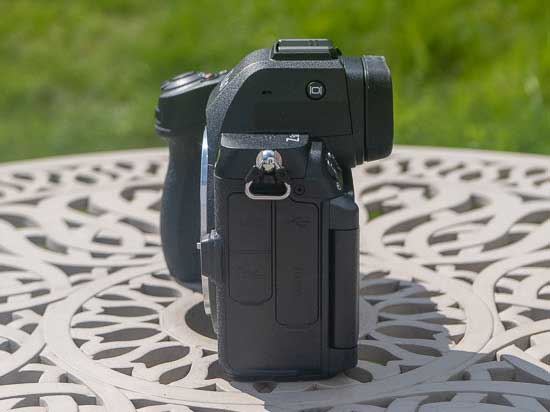
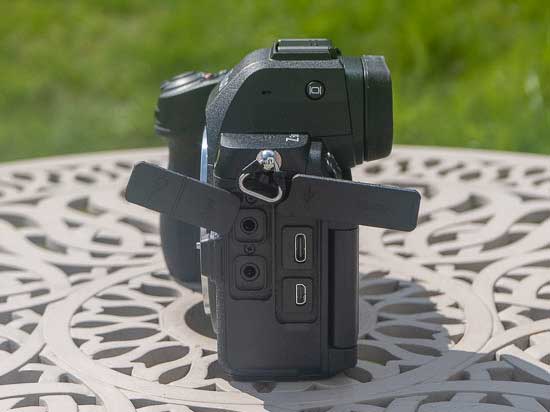


Conclusion
The Z5 II takes Nikon’s entry-level mirrorless camera forwards in veritable leaps and bounds, improving on the original model in lots of different areas, which is probably what you’d expect given that the Z5 was launched in 2020.
It’s also a more than viable alternative to the more expensive Z6 III model, offering enough comparable features and performance in a smaller, lighter body at a lower price-point, making it the better choice for a lot of users.
With a wealth of improvements to burst shooting rates and pre-release capture, auto-focusing speed and reliability, class-leading IBIS and the electronic viewfinder, the Z5 II is well-suited to capturing both stills and video of wildlife, sports and anything that moves quickly, something that couldn’t be confidently said about its predecessor.
It’s also a much better option for videographers thanks to the inclusion of 4K/60p recording, which the original model didn’t offer at all, and a cropless 4K/30p mode (the Z5 applied a massive 1.7x crop).
Add in 1080/120p super-slow-mo, N-Raw internal recording to UHS-II SD card, 10-bit N-Log recording for advanced profiling during post-production plus HLG and SDR modes, RED Luts, improved electronic VR, the Product Review mode from the Z50 II, 2x High-Res zoom with any lens, a video self-timer and USB streaming, and its very clear indeed that five years has been very kind to the Z5 II.
Commendably the official price hasn’t gone up by too much since the 2020 launch of the Z5, despite a considerable amount of global turmoil.
You do need to consider if really you need the Z5 II if you already have a Z5, or, as the latter camera is still on sale, if you’re contemplating picking one up for the first time. If budget is a big concern, you can save a hefty chunk of cash by either sticking with what you’ve already got or plumping for the previous, but not yet discontinued, model.
Unless you can pick up the original model at a hefty discount, we’d definitely advise opting for the much more capable 2025 version. In many ways the Z5 II goes way beyond its entry-level billing and is more than good enough to tempt would-be Z6 III buyers to save some serious cash…
| Ratings (out of 5) | |
|---|---|
| Design | 4.5 |
| Features | 4.5 |
| Ease-of-use | 4 |
| Image quality | 4.5 |
| Value for money | 4 |
Main Rivals
Listed below are some of the rivals of the Nikon Z5 II.
The new Canon EOS R8 full-frame mirrorless camera integrates the image quality and autofocusing from the more expensive EOS R6 Mark II with the smaller, lighter and simpler body of the cheaper EOS RP. Is the resulting camera a resounding success or a terrible mish-mash? Find out now by reading our in-depth Canon EOS R8 review…
The Z5 is Nikon’s brand new entry-level full-frame mirrorless camera, sitting below the mid-range Z6 and flagship Z7 models in the three-camera lineup, and above the APS-C sensor Z50. Designed to compete with the likes of the Canon EOS R, Sony A7 III and Panasonic Lumix S1, does the Z5 have what it takes to stand out in an increasingly crowded market? Find out now by reading our in-depth Nikon Z5 review, complete with full-size sample photos and videos.
The Nikon Z6 III is a new enthusiast full-frame hybrid mirrorless camera with a revolutionary partially stacked sensor and an amazing electronic viewfinder. Is this the best all-round prosumer mirrorless camera on the market? Find out now by reading our in-depth Nikon Z6 II review, complete with full size sample photos and videos…
Vintage, retro, heritage – Nikon are back with the Zf, a very modern 35mm full-frame digital camera housed inside a body that’s clearly been inspired by the classic FM2 SLR from the 1980s. We take an in-depth look at the Nikon Zf in our full review, complete with full-size sample photos and videos.
Finally! The new Lumix S5 II is the first ever Panasonic camera to have a phase hybrid detection AF system, answering the critics of its contrast-based DFD system. But does this powerful hybrid photo and video camera have what it takes to beat its main rivals? Find out now by reading our in-depth Panasonic Lumix S5 II review, complete with full-size sample photos and videos.
We’ve kicked off our Panasonic Lumix S9 review with sample JPEG and RAW images, product shots and more…
The new Sony Alpha A7 IV is a new 33 megapixel, 4K/60p video, 10fps burst shooting, cutting-edge auto-focusing hybrid full-frame mirrorless model that pulls no punches in its bid to be the only camera that you need. Find out why we think this is one of the best all-round cameras of 2021 by reading our in-depth Sony A7 IV review…
Review Roundup
Reviews of the Nikon Z5 II from around the web.
The Nikon Z5 II may be the new ‘entry’ point into Nikon’s full-frame mirrorless ecosystem, but there’s nothing basic about its spec sheet or performance. It has inherited much of the top-end tech from cameras higher up the range and packaged them into an affordable body, including intelligent subject recognition and advanced autofocus that will help improve your hit rate in capturing sharper shots.
Read the full review »
A great spec sheet and very little to dislike, plus a tempting price point makes the Z5 II a fantastic all-rounder for a variety of different photographers.
Read the full review »
The Nikon Z5 II is a calculated and well-executed camera that blurs the line between affordability and performance. Despite being angled as the brand’s entry-level model, the body has received significant upgrades over its rather pedestrian predecessor. This is effectively a mid-range camera at an outstanding price, and one that benefits massively from inheriting the excellent subject-detection autofocus of Nikon’s pricier bodies.
Read the full review »
Your Comments

![[2025 Upgraded] Retractable Car Charger, SUPERONE 69W Car Phone Charger with Cables Fast Charging, Gifts for Men Women Car Accessories for iPhone 16 15 14 13 12, Samsung, Black](https://i1.wp.com/m.media-amazon.com/images/I/61SaegZpsSL._AC_SL1500_.jpg?w=300&resize=300,300&ssl=1)



![[True Military-Grade] Car Phone Holder【2024 Stronger Suction & Clip】 Universal Cell Phone Holder for Car Mount for Dashboard Windshield Air Vent Long Arm Cell Phone Car Mount Thick Case,Black](https://i2.wp.com/m.media-amazon.com/images/I/715PBCuJezL._AC_SL1500_.jpg?w=300&resize=300,300&ssl=1)
![[エレコム] スマホショルダー ショルダーストラップ 肩掛け ストラップホールシート付属 丸紐 8mm P-STSDH2R08](https://i3.wp.com/m.media-amazon.com/images/I/51BMFf06pxL._AC_SL1500_.jpg?w=300&resize=300,300&ssl=1)







